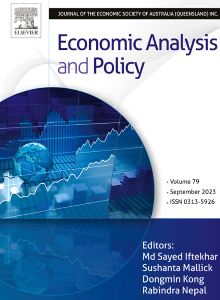Green finance and artificial intelligence: Catalysts for promoting sustainability?
IF 8.7
2区 经济学
Q1 ECONOMICS
引用次数: 0
Abstract
The roles of green finance (GF) and artificial intelligence (AI) are essential to be comprehensively investigated for promoting sustainability. This study uses the TVP-VAR-SV model to reveal the time-dependent interactions among GF, AI, and environmental, social and governance (ESG)-related uncertainty index (ESGUI). The empirical findings demonstrate that GF significantly reduces ESGUI, indicating its stabilizing role in sustainability markets. AI exhibits influences characterised by initial ESGUI elevation during early-stage implementation, except 2024-2025, followed by progressive ESGUI reduction in subsequent phases. It could be concluded that green finance and artificial intelligence promote sustainability, albeit with inherent lags of the latter. GF has a favourable impact on AI, while AI reciprocally enhances GF development during the observed periods except for COVID-19. Empirical comparisons demonstrate the TVP-VAR-SV model’s superior performance relative to the traditional VAR model in capturing time-varying parameter dynamics while maintaining result reliability. Further, other robustness tests, including extended control variables and alternative measures, consistently confirm the core results. Against the backdrop of increased uncertainties globally, this paper puts forward strategies used to augment the contribution of GF and AI in improving sustainability.
绿色金融与人工智能:促进可持续发展的催化剂?
绿色金融(GF)和人工智能(AI)的作用对于促进可持续发展至关重要。本研究使用TVP-VAR-SV模型揭示了GF、AI和环境、社会和治理(ESG)相关不确定性指数(ESGUI)之间的时间依赖相互作用。实证结果表明,GF显著降低了ESGUI,表明其在可持续性市场中的稳定作用。除了2024-2025年,人工智能的影响表现为在早期实施阶段初始ESGUI提升,随后在后续阶段逐步降低ESGUI。可以得出结论,绿色金融和人工智能促进了可持续性,尽管后者具有内在的滞后性。GF对AI产生有利影响,而AI在除COVID-19外的观测期间相互促进GF的发展。实证比较表明,与传统VAR模型相比,TVP-VAR-SV模型在捕获时变参数动态的同时保持了结果的可靠性。此外,其他稳健性测试,包括扩展控制变量和替代措施,一致地证实了核心结果。在全球不确定性增加的背景下,本文提出了提高GF和AI在提高可持续性方面的贡献的策略。
本文章由计算机程序翻译,如有差异,请以英文原文为准。
求助全文
约1分钟内获得全文
求助全文
来源期刊

Economic Analysis and Policy
ECONOMICS-
CiteScore
9.80
自引率
9.20%
发文量
231
审稿时长
93 days
期刊介绍:
Economic Analysis and Policy (established 1970) publishes articles from all branches of economics with a particular focus on research, theoretical and applied, which has strong policy relevance. The journal also publishes survey articles and empirical replications on key policy issues. Authors are expected to highlight the main insights in a non-technical introduction and in the conclusion.
 求助内容:
求助内容: 应助结果提醒方式:
应助结果提醒方式:


